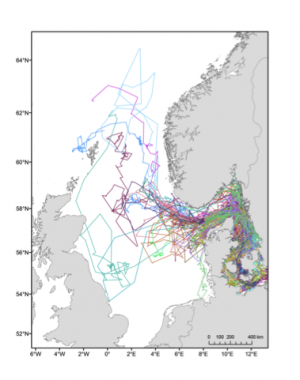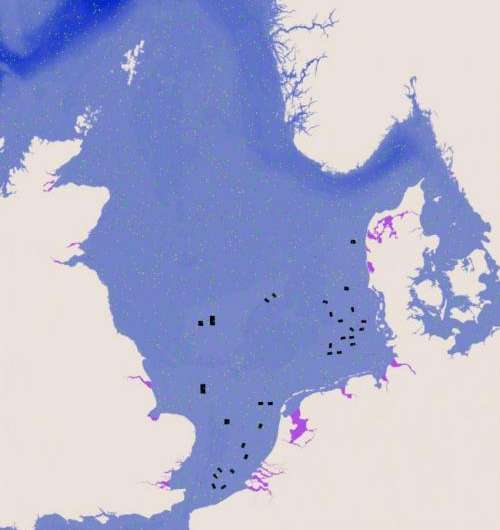Computer to simulate harbor porpoises

Researchers at Aarhus University, Denmark, use a computer model to predict the impact of new offshore wind farms on the population of harbour porpoises in the North Sea. A consortium of international energy companies has commissioned the project and funds the independent research.
How do harbour porpoises react to offshore wind turbines? The answer is important - not only for the porpoises themselves, but also for the energy companies building offshore wind farms in the North Sea. They have to provide an assessment of how the wind turbines will affect the species covered by the European Commission's Habitats Directive at a population level. And the harbour porpoise is one of the species that must be considered.
A consortium of five international energy companies has therefore taken the initiative to launch the DEPONS (Disturbance Effects on the Harbour Porpoise Population in the North Sea) research project, which aims to study how the population of harbour porpoises in the North Sea is affected when new offshore wind farms are built. Spearheading the consortium is Vattenfall, one of Europe's largest producers of electricity. The consortium plans to build a total of several thousand wind turbines in the North Sea. The other energy companies consist of Eneco, Forewind, SMart Wind and East Anglia Offshore Wind.
Companies sponsor research into the behaviour of porpoises
The project is being carried out by researchers at the Department of Bioscience, Aarhus University, Denmark. They are experts in converting data collected from the monitoring of marine mammals to computer models that can imitate the behaviour of the animals and thereby predict how the population may be affected by different influences on their habitat.
The researchers have previously carried out studies of the behaviour of harbour porpoises in the inner Danish waters. They will now provide the wind turbine consortium with a computer program they can use to try and understand the potential disturbance effects of their proposed activities on harbour porpoise within the North Sea.

"We're developing a computer model that is directly linked to the behaviour of the porpoises in relation to noise, and it's the first time that this type of individual-based population model is being used for the management of natural resources," says Senior Researcher Jacob Nabe-Nielsen, Department of Bioscience, who is heading the project.
Jacob has assembled a group of researchers who have expert knowledge in different areas, including the impact of noise on the porpoises, how they are distributed in time and space, and how their behaviour is affected by where they are located. Together, the researchers can shed light on the potential impact of wind farms on the harbour porpoise population.
"The companies can't influence the results, of course, and they're happy to provide support for carrying out the research because they need knowledge in this area. They want to ensure that there will be more research in a particular field, while the researchers remain totally independent at the same time," says Jacob Nabe-Nielsen. The consortium has so far supported the project with funds amounting to more than DKK 11 million.
Computer model is a simulation of reality
The researchers use data on the behaviour of real animals when modelling the population. Among other things they use satellite tracking data and aerial survey data to follow the porpoises - and the aim of the computer model is to use these data for making a realistic simulation of where individual animals go, how they forage for food, whether they are displaced by noise from the construction of wind turbines, etc. The computer model can be compared with a sim game, a type of computer game where the virtual world is a simulation of reality - with the one difference that the researchers continuously test to see whether the patterns generated by the model (for example the distribution of porpoises in the area) correspond to those observed in nature. The virtual porpoises behave just as they do in their natural habitat. For example, the mortality rate is increased if there are too many of them.
In their porpoise computer model, the researchers are able to make scenarios with different factors that imitate reality in the North Sea - such as shipping, changing amounts of food, etc.
It is also possible to place offshore wind farms at different locations in the model and see how this affects the populations of virtual porpoises.
"However, it's a model that's based on loads of calculations and this means there are also uncertainties. It's just like climate models. It can't precisely predict what's going to happen in future either, but it can predict the relative consequences of different management actions," says Jacob Nabe-Nielsen.
Project will be completed in two years
The model will be adjusted on an ongoing basis as new information comes to hand on the behaviour of the porpoises. Research has previously shown that porpoises are displaced by the loud noise associated with driving piles for the wind turbine foundations. However, nobody knows as yet how this affects the population.
The DEPONS project will be completed in two years, but the initial results will be presented and discussed with the Advisory Panel at the annual meeting in late-November. Representatives from authorities in the Netherlands, Germany and the UK will be attending the meeting, and they are following the project with keen interest.
Provided by Aarhus University





















